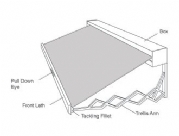 Add My Company
Add My Company
Sign In

Traditional Awnings
The 'traditional' blind as we know it today was the standard form of shop blind before the introduction of folding arms. It has been updated by the use of modern materials and is specified mainly for use on shops within conservation areas and other areas of special interest, although it can be fitted in any location.
Types and operation
Traditional blinds are usually supplied with arms and slides and occasionally with trellis extension arms. Pivot or 'shoe' arms are also available.
The blinds with arms and slides or trellis arms are supplied with a pull down pole for operation. Those supplied with pivot arms can be operated by gearbox or electric motor as well as by means of a pole.
The blinds are wound on helical spring rollers, or on geared or electric motorised rollers. The rollers are housed in specially constructed wooden blind boxes with wooden front laths of a raised panel or ogee profile.
Blind boxes were originally fixed above the name fascia or entablature, and this allowed for the blind cloth to be set at a steep angle which gave a pleasing aspect to the blind, better ventilation and better weathering.
The present tendency is for blind boxes to be fitted below the name fascia panel and consequently a much flatter blind is the result. This sometimes calls for the introduction of brass rainwater drain eyelets on the cover.
Wherever possible, consideration should be given to positioning the blind box at the highest level.
Fabric
Blind coverings are in the main made from woven acrylic fibre, with an incorporated dirt repellent. This material has the appearance of traditional cotton duck but is more robust. Reinforced PVC blind cloths are also available.
Components
Box
A properly constructed weather box, with a slot at the front for the blind to pass through, usually made from good quality timber.
Roller
A steel or aluminium tube with a steel axle on which a helical spring is mounted.
Set-off plates, cup plates, roller brackets
A malleable iron casting in which the roller is suspended.
Front lath or rail
This is the leading edge of the blind and its twin function is to retain the outer edge of the cloth and to form the closure piece to the front slot of the blind box when the blind is not in use.
Cover or cloth
This is the material or fabric which is held in tension between the roller and lath and is the shading component of the blind.
Tacking fillet or tacker
This is the substantial piece of softwood that is secured to the back of the lath. Its function is to have the cover nailed to it so as to hold the cover in position.
Arms and slides
These are made from mild steel and are the means of projecting the blind outwards from the face of the building to which it is attached. The slides are the means of adjustment in height between the required headroom and the position of the bottom of the blind arms when in repose.
Pivot arms
Are ordinary arms fitted without slides where there is sufficient height available for the blind arms to be accommodated in the vertical position whilst sufficient headroom is also available below the lowest part of the arm.
Storm chain, supporting chain, safety chain
These suspend the blind in position in case the cloth or cover should come adrift from the lath and also maintain the headway.
Trellis arms
These are made from criss-cross scissor-type slats made from mild steel. These arms also have vertical slides.
Long arm or blind pole
A wooden pole with a cast malleable hook for pulling the blind out from the box.
Tops and bottoms or slide castings
The malleable castings that secure the top and bottom of the slide bar in position.
Cannon
The malleable casting securing the inner end of the blind arm to the pivot bolt on the slide box or shoe.
Slide box
The casting that runs up and down the slide bar with pivot bolt and arm attached.
Shoe
The casting forming the fixed pivo
For more information on Traditional Awnings explained talk to British Blind & Shutter Association
Enquire Now
List your company on FindTheNeedle.
